I am trying to fill shapes with colors gradient corresponding to a continuous variable. I don't have any errors, but it does not print on the graph.
I tried to use as.numeric to make sure the variable is continuous.
The NMDS is already calculated and it works. Everything works except the color gradient.
ggplot()+
geom_point(data = NMDS.all.taxa, aes(y = NMDS2, x = NMDS1, fill = env$elev.num), shape = env$saison, size = 4)+ #this is the points
geom_path(data = df_ell.all.taxa, aes(x = NMDS1, y = NMDS2, colour = group))+ ##Elipses
scale_fill_gradient2(low = "green", mid = "blue", high = "red", midpoint = 1800)+ ##fill
theme_bw()+
theme(panel.background = element_blank(),
panel.grid.major = element_blank(), #remove major-grid labels
panel.grid.minor = element_blank(), #remove minor-grid labels
plot.background = element_blank()
)
It gives me a NMDS with everything except that the shapes are empty. Not any Error codes.
To recreate aspects of the data:
library(vegan)
Macro_AUG_2019_rep.<- matrix(0:10, ncol = 20, nrow = 50)
env <- data.frame(Traitement = sample(c("n","r"),50, replace = TRUE),
saison = sample(c("S","A"),50, replace = TRUE),
Elevation = sample(1000:1049),
Site = sample(c("lake1","lake2","lake3","lake4","lake5","lake6","lake7"),
50, replace = TRUE))
spe.nmds <- metaMDS(Macro_AUG_2019_rep., distance='bray', k=2, try=999, maxit=500)
NMDS.all.taxa <- data.frame(NMDS1 = spe.nmds$points[,1],
NMDS2 = spe.nmds$points[,2],
group = env$Traitement,
sites = env$Site)
veganCovEllipse <- function(cov, center = c(0, 0), scale = 1.75, npoints = 100) {
theta <- (0:npoints) * 2 * pi/npoints
Circle <- cbind(cos(theta), sin(theta))
t(center + scale * t(Circle %*% chol(cov)))
}
df_ell.all.taxa <- data.frame()
for(g in levels(NMDS.all.taxa$group)){
df_ell.all.taxa <- rbind(
df_ell.all.taxa,
cbind(as.data.frame(with(NMDS.all.taxa[NMDS.all.taxa$group == g, ],
veganCovEllipse(cov.wt(cbind(NMDS1, NMDS2),
wt=rep(1 / length(NMDS1),
length(NMDS1)))$cov,
center=c(mean(NMDS1), mean(NMDS2))))),
group = g)
)
}
NMDS.mean.all.taxa = aggregate(NMDS.all.taxa[ ,c("NMDS1", "NMDS2")],
list(group = NMDS.all.taxa$group),
mean)

